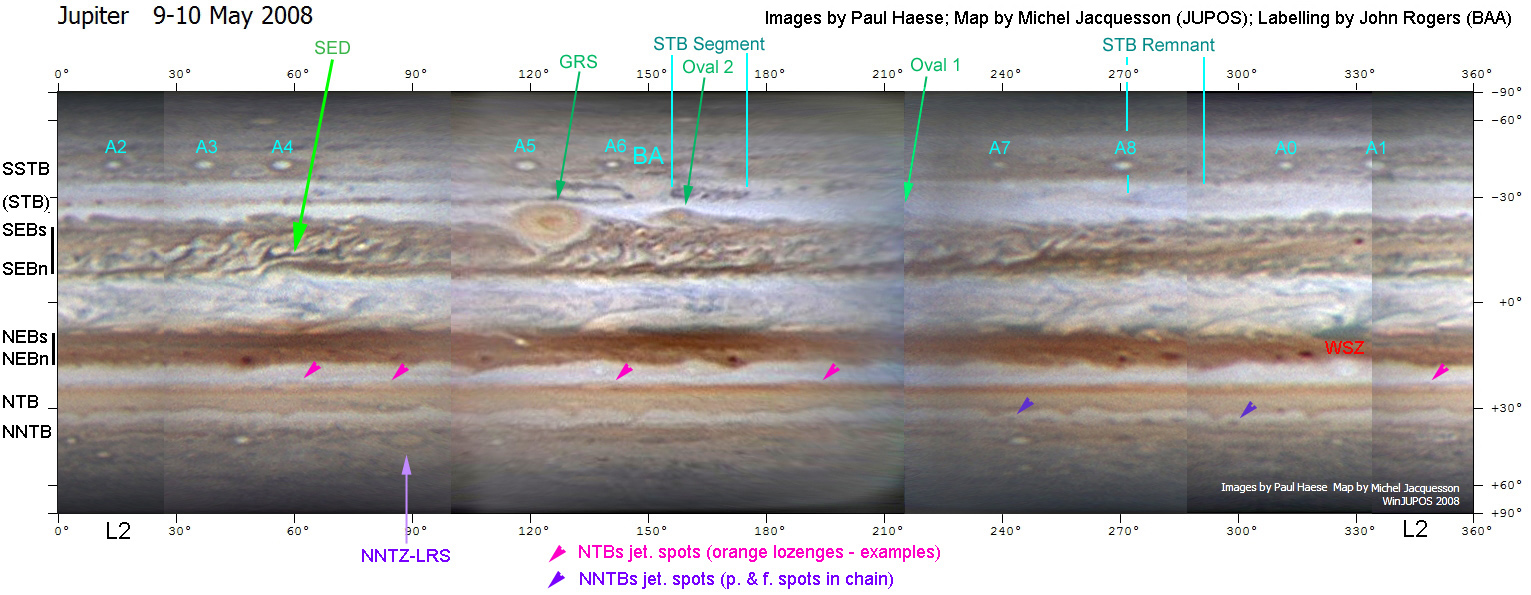| Jupiter:2008/05/09-10 maps by John H.Rogers |
Hi everyone,
Jupiter in 2008 (1) General comments and map:
The attached map shows the planet on 2008 May 9-10. Images were taken by Paul Haese (S. Australia) and compiled into a cylindrical map by Michel Jacquesson (JUPOS project), and annotated by JHR. Thanks are due to other observers (especially in Australia and the Philippines) and the other members of the JUPOS team, who have enabled us to continue our comprehensive survey of the weather on Jupiter.
This map shows Jupiter during a rapid transition in climate. In 2007 there were spectacular outbreaks of storms around several of the belts and zones. Now we can see the aftermath as these disturbances are settling down towards a more normal state.
The SEB is full of turbulent streaks, as last year's activity has not yet ended. On its south edge, the vigorous eddying activity of the last 2 years has been concentrated into two new anticyclonic ovals, and one of these is a new Red Spot (Oval 2). It is alongside the oval that turned red in 2006 (Oval BA - now paler), and both are approaching encounter with the Great Red Spot.
The NEB is dark reddish and contains small dark cyclonic ovals called barges. These are both sequels to turbulent activity last year, and we are presently watching as some of the new barges collide and merge. The NTB is a broad orange belt, which reappeared in an extraordinarily energetic outburst of storms last year. The reddish colour is an aftermath of this activity. The motion of the orange 'lozenges' on its south edge is enabling us to follow the deceleration of the jet-stream to its more normal state. There is also an outbreak of jet-stream spots on the NNTB south edge.
Higher latitudes were not visibly affected by the global upheaval, but contain interesting sets of long-lived circulations. Oval BA and the STB segment following it represent one of two large long-lived circulation complexes in the STB; the other, barely visible but persistent, is the cyclonic 'STB Remnant'. Further south, in the SSTB, yet another small anticyclonic white oval has appeared, bringing the total to nine, separated by low-contrast cyclonic cells. The NNTZ contains another Little Red Spot, which has existed for several years. Like those in the southern hemisphere it is an anticyclone topped with high-altitude reddish haze.
A MORE DETAILED INTERIM REPORT WILL FOLLOW SOON.
Happy observing!
John

John H. Rogers,Ph.D.
Jupiter Section Director,
[British Astronomical Association.]
================================================================================================== GOTO English
(和訳 三 品 利 郎) こんにちは、皆さん。 2008の木星概評(1)と木星図:この木星図は2008年5月9日〜10日の木星面を示しています。 画像は、ポールHaese(S.オーストラリア)によって撮影され、ミシェルJacquesson (JUPOSプロジェクト)によって木星図に編集されました。そして、J.H.Rogersよって注釈が 付されました。他の観察者(特にオーストラリアとフィリピンの)とJUPOSチームの他のメン バーにも感謝します。(彼等は、私たちが木星気象の広範囲に渡る調査を続けてることを 可能にしました。) この地図は木星の気候が急に変化している最中であることを示しています。2007年に、 ベルトといくつかのゾーンの周りで、壮観なストームのアウトブレークがありました。 今は、これらの撹乱が正常な状態に向かって落ち着いていますが、その余波を見ること ができます。 SEBは、昨年の活動がまだ終わっておらず、乱流のストリークでいっぱいです。 SEBの南縁では、ここ2年の活発な循環気流の活動が2つの新しい高気圧性の楕円暗斑に集結 されました。そして、これらの1つは新しいRed Spot(楕円斑2)です。それが2006年に赤化し た楕円白斑(楕円形のBA--、今は淡い)と並んでいます。両方が大赤斑との遭遇に近づいています。 NEBには、やや暗赤色のバージと呼ばれる小さい暗い低気圧性の楕円暗斑が幾つもあります。 これらは、共に、昨年からの乱流活動の続きであり、私たちは現在、いくつかの新しいバージ が衝突して合併するのを見ています。 NTBは広いオレンジのベルトです。(そのベルトは昨年、異常にエネルギッシュなストームの アウトバーストで復活しました)。やや赤い色はこの活動の余波です。 南縁におけるオレンジの'ひし形'の動きは、より正常な状態へとジェット気流が減速するのを、 私たちに追跡可能にしています。 また、NNTB南の縁に、ジェット気流スポットのアウトブレークがあります。 高緯度には、大域的は大変動の影響を明らかに受けなかったが、興味深い持続性の循環があ ります。 オーヴァルBAと南温帯縞の領域は南温帯縞の2つの大きい永続的な循環の複合体の1つを表し ています。 ほとんど目に見えませんが、永続白斑のもう片方が、低気圧性の'南温帯縞レムナント'です。 さらに南、南南温帯縞では、別の小さい「高気圧性」の白色楕円斑が現れています。低コン トラストなサイクロンのセルによって切り離され、合わせて9つあります。 NNTZには別の小赤斑があります。(それはは数年間存在しています。)南半球のように、それ は頂上をやや赤いもやに被われた高気圧です。 直ぐに、より詳細な中間報告を発表します。 よい観測を! ジョン
[イギリス天文協会木星セクション ディレクター Dr. J.H.Rogers ]
ALPO-Japan Latest
Jupiter Section